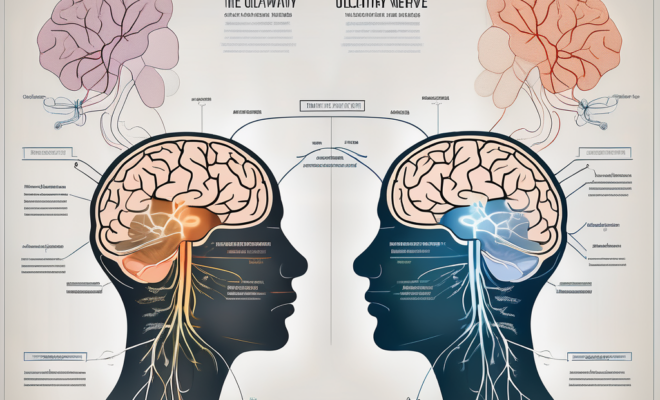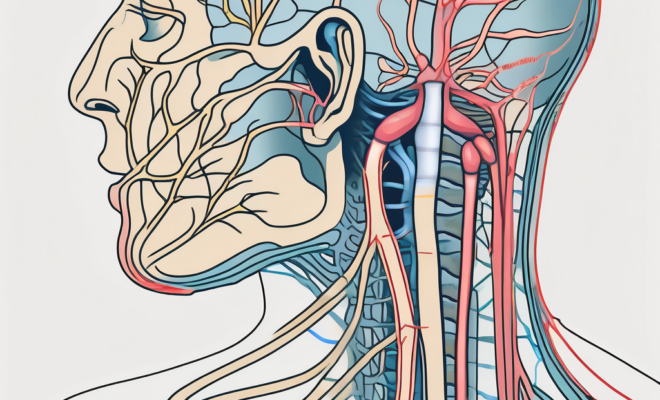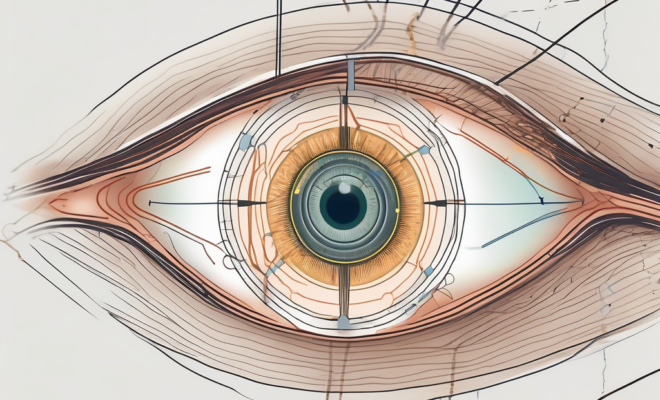The Role of the Olfactory Nerve in Sense of Smell

The olfactory nerve plays a crucial role in our sense of smell, allowing us to detect and perceive a wide range of odors. Understanding the function and anatomy of this nerve is key to unraveling the mysteries of our olfactory system.
Understanding the Olfactory Nerve
The olfactory nerve, also known as cranial nerve I, is responsible for relaying sensory information related to smell from the nasal cavity to the brain. It is one of the twelve cranial nerves, which are essential for various sensory and motor functions.
Anatomy of the Olfactory Nerve
The olfactory nerve consists of millions of specialized nerve cells called olfactory receptor neurons (ORNs). These neurons are located in the olfactory epithelium, a specialized tissue lining the upper part of the nasal cavity. Each ORN extends tiny hair-like structures called cilia into the nasal cavity to capture odor molecules.
Upon stimulation, these odor molecules bind to specific receptors on the cilia, initiating a cascade of electrical signals in the olfactory receptor neurons.
But did you know that the olfactory epithelium is not just a passive receptor of smells? It also plays a role in the immune system. The olfactory epithelium contains immune cells, such as macrophages and lymphocytes, which help protect the nasal cavity from pathogens and foreign substances. These immune cells work in conjunction with the olfactory receptor neurons to ensure the overall health and function of the olfactory system.
Function of the Olfactory Nerve
The olfactory nerve is responsible for transmitting these electrical signals, or action potentials, generated by the olfactory receptor neurons to the olfactory bulb in the brain. The olfactory bulb then processes and interprets these signals, enabling us to perceive and distinguish various smells.
Have you ever wondered why certain smells trigger vivid memories or intense emotions? Well, the direct connection between the olfactory nerve and the olfactory cortex is the key. Unlike other sensory systems, where information is first relayed to the thalamus before reaching the cortex, the olfactory nerve bypasses the thalamus and projects directly to the olfactory cortex. This direct connection allows for the rapid processing of smells and facilitates quick emotional and memory associations with specific odors.
Furthermore, the olfactory nerve is not only involved in our sense of smell but also has a role in our overall well-being. Studies have shown that certain smells can have therapeutic effects on our mood and emotions. For example, the scent of lavender has been found to promote relaxation and reduce anxiety, while the smell of citrus fruits can increase alertness and improve mood. These effects are mediated by the olfactory nerve, which transmits the signals from these smells to the brain, triggering the release of neurotransmitters that influence our mental state.
The Olfactory System: An Overview
The olfactory system is a complex network of structures involved in the detection, processing, and perception of smells. Understanding the components and mechanism of this system is essential for comprehending the role of the olfactory nerve in our sense of smell.
Components of the Olfactory System
The olfactory system consists of several key structures, including the olfactory epithelium, olfactory receptor cells, olfactory bulb, olfactory cortex, and other associated brain regions. These structures work together to ensure the proper detection and interpretation of smells.
At the heart of the olfactory system lies the olfactory epithelium, a specialized tissue lining the nasal cavity. This remarkable tissue contains millions of olfactory receptor cells, each equipped with specialized receptors that can detect a wide range of odor molecules. These receptor cells are the first line of defense in our olfactory system, playing a crucial role in capturing and translating the chemical information carried by odors.
Once the odor molecules enter the nasal cavity, they come into contact with the olfactory epithelium. The receptors on the olfactory receptor cells bind to specific odor molecules, initiating a cascade of events that ultimately leads to the perception of smell. This intricate process is a testament to the remarkable precision and sensitivity of our olfactory system.
Furthermore, the olfactory system is intimately connected with other brain regions involved in memory, emotion regulation, and decision-making, enabling odor-evoked experiences to have a profound impact on our daily lives. The olfactory cortex, for example, plays a crucial role in processing and interpreting the information received from the olfactory bulb. It is here that the perception of smell takes place, allowing us to distinguish between the aroma of freshly baked bread and the scent of a blooming rose.
How the Olfactory System Works
When airborne odor molecules enter the nasal cavity, they encounter the olfactory epithelium, which contains the olfactory receptor cells. These cells, equipped with specialized receptors, detect the specific odor molecules that bind to them.
Once the odor molecules are detected, the olfactory receptor cells generate electrical signals in response, which are then transmitted to the olfactory bulb via the olfactory nerve. The olfactory bulb, located at the base of the brain, acts as a relay station where the information is processed and integrated.
From the olfactory bulb, the processed information is then sent to the olfactory cortex, a region of the brain responsible for the interpretation and perception of smell. It is in this intricate network of neural connections that the richness and complexity of our olfactory experiences are formed.
This intricate process allows us to differentiate between various odors and form associations with specific scents, contributing to our rich olfactory experiences. From the nostalgic scent of a childhood memory to the enticing aroma of a favorite dish, our olfactory system plays a vital role in shaping our perception of the world around us.
The Connection Between the Olfactory Nerve and Smell
The sense of smell, also known as olfaction, is a complex and fascinating sensory experience that relies heavily on the function of the olfactory nerve. Understanding the process of smell perception and the role of the olfactory nerve can shed light on the intricate connection between them.
The Process of Smell Perception
- Odor molecules enter the nasal cavity through inhalation or direct exposure.
- The odor molecules interact with the olfactory receptor cells in the olfactory epithelium.
- The olfactory receptor cells generate electrical signals.
- The electrical signals are transmitted via the olfactory nerve to the olfactory bulb.
- The olfactory bulb processes and integrates the signals.
- The processed signals are sent to the olfactory cortex for further interpretation and perception.
The Olfactory Nerve’s Role in Smell
The olfactory nerve is the primary conduit through which smell information travels from the olfactory receptor cells to the brain. Its proper functioning is crucial for accurate transmission of sensory signals and preservation of our sense of smell.
But what happens if the olfactory nerve is compromised? Well, damage or dysfunction of the olfactory nerve can lead to olfactory disorders, such as anosmia (the complete loss of smell) or hyposmia (reduced sense of smell). These conditions can significantly impact one’s quality of life, affecting daily activities, appetite, and emotional well-being.
Imagine waking up one day and no longer being able to smell the aroma of freshly brewed coffee or the scent of blooming flowers. Anosmia can be a disorienting experience, as our sense of smell is intricately connected to our memories and emotions. It can affect our ability to enjoy food, as smell plays a crucial role in our perception of taste. Additionally, it can impact our safety, as we rely on our sense of smell to detect potential dangers, such as gas leaks or spoiled food.
Hyposmia, on the other hand, can be equally frustrating. It may lead to a reduced ability to detect subtle scents or differentiate between different odors. This can affect our appreciation for the world around us, as smell is closely linked to our overall sensory experience. It can also impact our social interactions, as we rely on our sense of smell to detect pheromones and other chemical signals that play a role in attraction and communication.
While the olfactory nerve may seem like a small part of our overall sensory system, its role in our sense of smell is undeniable. It is a delicate and intricate connection that allows us to experience the world through scent. So the next time you take a deep breath and inhale a pleasant aroma, take a moment to appreciate the incredible journey that odor molecules take, guided by the olfactory nerve, to bring you that sensory delight.
Disorders Related to the Olfactory Nerve
Olfactory disorders can arise from various causes, and their impact on individuals can be significant. Examining the causes, symptoms, and diagnosing these disorders is essential for effective management and treatment.
The olfactory nerve, also known as the first cranial nerve or cranial nerve I, plays a crucial role in our sense of smell. Any disruption or damage to this nerve can lead to olfactory disorders, affecting an individual’s quality of life and overall well-being.
Causes of Olfactory Disorders
Olfactory disorders can be caused by a wide range of factors, including:
- Upper respiratory tract infections
- Head trauma or injury
- Neurological conditions
- Exposure to certain chemicals or toxins
- Aging
Additionally, conditions such as nasal polyps, sinus infections, and neurodegenerative diseases can also contribute to olfactory dysfunction. Understanding the underlying cause is crucial in determining the appropriate treatment approach and potentially reversing or managing the olfactory disorder.
Symptoms and Diagnosis of Olfactory Disorders
Individuals with olfactory disorders may experience various symptoms, including:
- Loss of smell
- Reduced ability to detect and differentiate odors
- Altered perception of smells
- Distorted or unpleasant smells
Diagnosing olfactory disorders often involves a comprehensive evaluation, including medical history assessment, physical examination, and olfactory testing. Olfactory testing may employ methods such as odor identification tests, odor threshold tests, or imaging techniques.
Furthermore, the impact of olfactory disorders extends beyond the inability to enjoy food or detect hazards such as gas leaks. Loss of smell can also affect one’s emotional well-being, as the sense of smell is closely linked to memory and can evoke strong emotions and nostalgia. Research continues to explore innovative treatments and therapies to address olfactory disorders and improve the quality of life for affected individuals.
Treatment and Management of Olfactory Disorders
While there is currently no cure for certain olfactory disorders, several treatment approaches and management strategies can help individuals cope with and potentially improve their symptoms.
Understanding the complexities of olfactory disorders is crucial in developing effective treatment plans. Olfactory disorders can stem from various causes, including upper respiratory infections, head trauma, neurological conditions, and exposure to certain chemicals. Each underlying cause may require a tailored approach to address the specific issues contributing to the olfactory dysfunction.
Medical Treatments for Olfactory Disorders
Medical interventions for olfactory disorders may include:
- Nasal medications, such as corticosteroids
- Olfactory training exercises
- Surgical interventions in specific cases
It is essential to consult with healthcare professionals specialized in olfactory disorders to determine the most suitable treatment approach for each individual case.
In cases where olfactory disorders result from nasal polyps or other structural abnormalities, surgical interventions may be necessary to restore or improve the sense of smell. These procedures aim to correct any physical obstructions that hinder the olfactory system’s function, potentially leading to significant improvements in olfactory perception.
Lifestyle Changes and Coping Strategies for Olfactory Disorders
Individuals with olfactory disorders can adopt various lifestyle changes and coping strategies to enhance their quality of life, such as:
- Paying attention to food flavors and textures
- Using visual cues and other senses to identify potential dangers
- Practicing good oral hygiene
- Exploring alternative ways to experience pleasure, such as engaging in hobbies or listening to music
Support groups and counseling services may also be beneficial in providing emotional support and guidance for individuals navigating the challenges associated with olfactory disorders.
Furthermore, incorporating aromatherapy or scented candles in living spaces can stimulate other sensory experiences, compensating for the loss of smell. These alternative sensory inputs can evoke memories, improve mood, and create a more pleasant environment for individuals with olfactory impairments.
The Impact of Olfactory Disorders on Quality of Life
Olfactory disorders can have far-reaching effects beyond a mere loss of the sense of smell. The psychological and sociological implications associated with these conditions underscore the importance of recognizing and addressing their impact.
Psychological Effects of Olfactory Disorders
The loss or alteration of the sense of smell can lead to psychological consequences, including:
- Depression
- Anxiety
- Emotional distress
- Reduced overall life satisfaction
These psychological effects can significantly impact one’s well-being and overall quality of life, highlighting the need for comprehensive support and management strategies.
Social and Personal Implications of Olfactory Disorders
Olfactory disorders can also affect an individual’s personal and social life. Smell plays a vital role in our interpersonal relationships, influencing attraction, memories, and emotional connections.
The loss or alteration of this sense can lead to challenges in various areas, including:
- Enjoying food and cooking
- Identifying potential dangers, such as spoiled food or gas leaks
- Participating fully in social gatherings and events
- Experiencing joy and pleasure from scent-related experiences
Awareness and understanding of these implications are essential in fostering empathy and support for individuals affected by olfactory disorders.
Furthermore, olfactory disorders can impact an individual’s professional life as well. Many careers rely on the ability to detect and identify specific scents, such as perfumers, chefs, and sommeliers. The loss of the sense of smell can be devastating for individuals in these professions, as it may hinder their ability to perform their job effectively and may even lead to a loss of employment.
In addition, olfactory disorders can have significant implications on an individual’s safety and well-being. The sense of smell serves as an early warning system, alerting us to potential dangers in our environment. Without this sense, individuals may be at a higher risk of not detecting hazardous substances, such as smoke, gas leaks, or spoiled food, which can have severe consequences for their health and safety.
Moreover, the loss of the sense of smell can result in a profound impact on an individual’s overall enjoyment of life. Scent-related experiences, such as the smell of freshly cut grass, blooming flowers, or a loved one’s perfume, contribute to our emotional well-being and can evoke powerful memories and emotions. Without the ability to perceive these scents, individuals may feel a sense of disconnection from the world around them, leading to a diminished sense of joy and pleasure.
In conclusion, olfactory disorders extend beyond the physical loss of the sense of smell. They have psychological, social, and personal implications that can significantly affect an individual’s quality of life. By recognizing and understanding these effects, we can work towards providing the necessary support and management strategies to improve the well-being of those affected by olfactory disorders.
Future Research Directions in Olfactory Neuroscience
The field of olfactory neuroscience continues to evolve, with ongoing research aiming to further unravel the complexities of the olfactory system. Advancements in understanding the structure and function of the olfactory nerve hold promise for potential therapies and interventions.
Advances in Olfactory Nerve Research
Researchers are investigating various aspects of the olfactory nerve, including:
- Cellular and molecular mechanisms underlying olfactory signaling
- Regeneration and repair of the olfactory nerve
- Interaction of the olfactory nerve with other brain regions
These advancements provide valuable insights into the olfactory system and may contribute to the development of novel treatment strategies.
Potential Therapies and Interventions for Olfactory Disorders
With a deeper understanding of the olfactory nerve and the olfactory system, researchers are exploring potential therapeutic approaches for olfactory disorders. These may include:
- Gene therapy to restore olfactory function
- Targeted drug delivery to the olfactory nerve
- Neuronal regeneration techniques
- Brain-computer interfaces to bypass damaged nerve pathways
While these potential therapies are still in the experimental stages, they offer hope for individuals affected by olfactory disorders.
In conclusion, the olfactory nerve, as a vital component of the olfactory system, plays an integral role in our sense of smell. Understanding its anatomy, function, and the intricate connection between the olfactory nerve and our olfactory experiences is crucial for unraveling the complexities of olfaction. Olfactory disorders can significantly impact an individual’s quality of life, highlighting the need for proper diagnosis, treatment, and support. Ongoing research in olfactory neuroscience holds promise for future advancements that may revolutionize the management of olfactory disorders and provide new insights into the fascinating world of smell.















